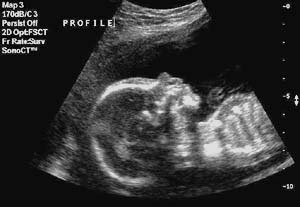18-20 Week Structural Assessment
| This ultrasound examination is often considered part of the routine obstetric care. The purpose of this examination is to assess:
Why at 18 weeks?Good detail can usually be obtained, allowing a more complete assessment of the baby's structure.Can every defect of the fetus be seen?No, a normal ultrasound examination cannot guarantee a normal fetus. Unfortunately there are still a few problems, which cannot be seen. We cannot see chromosome abnormalities, but may see changes indicating a higher likelihood of chromosome abnormality.Do I need a full bladder for the ultrasound?It is useful to have some fluid in the bladder to allow for better visualization of the fetus by keeping the uterus above the pelvic bones. This can be achieved without the bladder being so full as to be uncomfortable. |
|
Can I find out the sex of my baby?
Often the sex of the fetus can be seen. Sometimes it can not be seen due to the position of the fetus.Is it safe?
Diagnostic ultrasound has been in use since the late 1950's. To date the results of numerous follow-up studies on patients and children who had been examined before birth have failed to demonstrate any biological effect that could be attributed to the ultrasonic examination.Information Brochure
 |
The 18-20 Week Ultrasound Examination This examination assesses the number of babies in the uterus, the baby's age, the baby's physical development, the placenta's position and the amount of amniotic fluid around the baby. |




